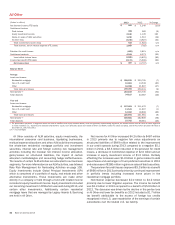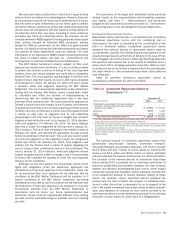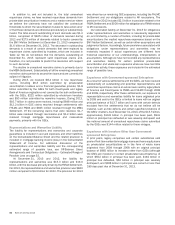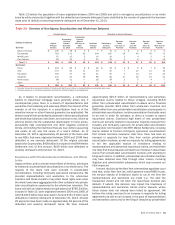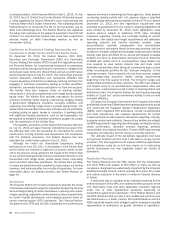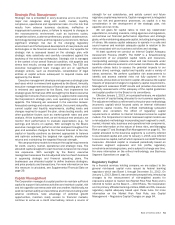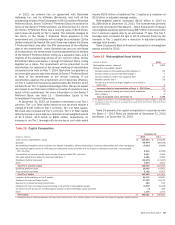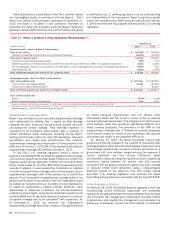Bank of America 2013 Annual Report Download - page 58
Download and view the complete annual report
Please find page 58 of the 2013 Bank of America annual report below. You can navigate through the pages in the report by either clicking on the pages listed below, or by using the keyword search tool below to find specific information within the annual report.56 Bank of America 2013
or prepaid product, which became effective April 1, 2012. On July
31, 2013, the U.S. District Court for the District of Columbia issued
a ruling regarding the Federal Reserve’s rules implementing the
Financial Reform Act’s Durbin Amendment. The ruling requires the
Federal Reserve to reconsider the $0.21 per transaction cap on
debit card interchange fees. The Federal Reserve has appealed
the ruling and a decision on the appeal is expected in the first half
of 2014. It is possible that revised rules could have a significant
adverse impact on debit interchange revenue as well as
transaction routing.
Limitations on Proprietary Trading; Sponsorship and
Investment in Hedge Funds and Private Equity Funds
On December 10, 2013, the Federal Reserve, OCC, FDIC,
Securities and Exchange Commission (SEC) and Commodity
Futures Trading Commission (CFTC) issued final regulations under
the Financial Reform Act implementing limitations on proprietary
trading as well as the sponsorship of or investment in hedge funds
and private equity funds (the Volcker Rule) and set a conformance
period that will expire on July 21, 2015. The Volcker Rule prohibits
insured depository institutions and companies affiliated with
insured depository institutions (collectively, banking entities) from
engaging in short-term proprietary trading of certain securities,
derivatives, commodity futures and options for their own account.
The Volcker Rule also imposes limits on banking entities’
investments in, and other relationships with, hedge funds or private
equity funds. The Volcker Rule provides exemptions for certain
activities, including market making, underwriting, hedging, trading
in government obligations, insurance company activities, and
organizing and offering hedge funds or private equity funds. The
Volcker Rule also clarifies that certain activities are not prohibited,
including acting as agent, broker or custodian. A banking entity
with significant trading operations, such as the Corporation, will
be required to establish a detailed compliance program to comply
with the restrictions of the Volcker Rule.
The statutory provisions of the Volcker Rule became effective
on July 21, 2012 and gave financial institutions two years from
the effective date, with the possibility for extensions for certain
investments, to bring activities and investments into compliance
with the statutory provisions. The Federal Reserve has now
extended the conformance period to July 21, 2015.
Although we exited our stand-alone proprietary trading
business as of June 30, 2011 in anticipation of the Volcker Rule
and to further our initiative to optimize our balance sheet, we are
still in the process of evaluating the full impact of the Volcker Rule
on our current trading activities and our ownership interests in and
transactions with hedge funds, private equity funds, commodity
pools and other subsidiary operations. The Volcker Rule will likely
increase our operational and compliance costs, reduce our trading
revenues, and adversely affect our results of operations. For more
information about our trading business, see Global Markets on
page 44.
Derivatives
The Financial Reform Act includes measures to broaden the scope
of derivative instruments subject to regulation by requiring clearing
and exchange trading of certain derivatives; imposing new capital,
margin, reporting, registration and business conduct requirements
for certain market participants; and imposing position limits on
certain over-the-counter (OTC) derivatives. The Financial Reform
Act grants to the CFTC and the SEC substantial new authority and
requires numerous rulemakings by these agencies. Swap dealers
conducting dealing activity with U.S. persons above a specified
dollar threshold were required to register with the CFTC on or before
December 31, 2012, and this registration requirement was
extended to guaranteed non-U.S. entities, requiring registration of
such entities by December 31, 2013. Upon registration, swap
dealers become subject to additional CFTC rules, including
measures regarding clearing and exchange trading of certain
derivatives, new capital and margin requirements and additional
reporting, external and internal business conduct, swap
documentation, portfolio compression and reconciliation
requirements for derivatives. Most of these requirements, with the
exception of margin, capital and exchange/swap execution facility
trading, have gone into effect for us, except with respect to swaps
between our non-U.S. swap dealers and some non-U.S. branches
of BANA with certain non-U.S. counterparties. Swap dealers are
now required to clear certain interest rate and index credit
derivative transactions when facing all counterparty types unless
either counterparty qualifies for the “end-user exception” to the
clearing mandate. These products will also likely become subject
to exchange/swap execution facility trading requirements
beginning in the first quarter of 2014. The timing for margin and
capital implementation remains unknown. The SEC must propose
and finalize many of its security-based swaps-related rules and
has, to date, implemented a small number of clearing-related and
definitional rules. The Financial Reform Act also requires banking
entities to “push out” certain derivatives activity to one or more
non-bank affiliates.
In Europe, the European Commission and European Securities
and Markets Authority (ESMA) have been granted authority to adopt
and implement the European Market Infrastructure Regulation
(EMIR), which regulates OTC derivatives, central counterparties
and trade repositories, and imposes requirements for certain
market participants with respect to derivatives reporting, clearing,
business conduct and collateral. Several of our entities are subject
to EMIR requirements regarding record keeping, marking to market,
timely confirmation, derivative contract reporting, portfolio
reconciliation and dispute resolution. Further EMIR-implementing
measures are expected, but the timing is currently unknown.
The ultimate impact of the derivatives regulations that have
not yet been finalized and the time it will take to comply remain
uncertain. The final regulations will impose additional operational
and compliance costs on us and may require us to restructure
certain businesses and may negatively impact our results of
operations.
Resolution Planning
The Federal Reserve and the FDIC require that the Corporation
and other BHCs with assets of $50 billion or more, as well as
companies designated as systemically important by the Financial
Stability Oversight Council, submit annually their plans for a rapid
and orderly resolution in the event of material financial distress
or failure.
A resolution plan is intended to be a detailed roadmap for the
orderly resolution of the BHC and material entities pursuant to the
U.S. Bankruptcy Code and other applicable resolution regimes
under one or more hypothetical scenarios assuming no
extraordinary government assistance. If the Federal Reserve and
the FDIC determine that our plan is not credible and we fail to cure
the deficiencies in a timely manner, the Federal Reserve and the
FDIC may jointly impose more stringent capital, leverage or liquidity
requirements or restrictions on growth, activities or operations.


